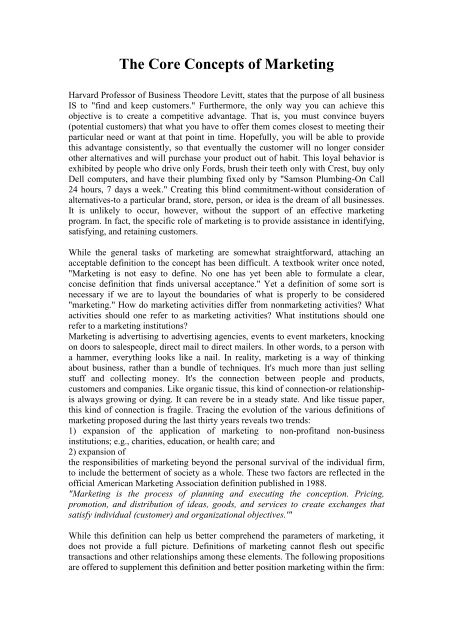The Core Concepts of Marketing
The Core Concepts of Marketing
The Core Concepts of Marketing
Create successful ePaper yourself
Turn your PDF publications into a flip-book with our unique Google optimized e-Paper software.
<strong>The</strong> <strong>Core</strong> <strong>Concepts</strong> <strong>of</strong> <strong>Marketing</strong><br />
Harvard Pr<strong>of</strong>essor <strong>of</strong> Business <strong>The</strong>odore Levitt, states that the purpose <strong>of</strong> all business<br />
IS to "find and keep customers." Furthermore, the only way you can achieve this<br />
objective is to create a competitive advantage. That is, you must convince buyers<br />
(potential customers) that what you have to <strong>of</strong>fer them comes closest to meeting their<br />
particular need or want at that point in time. Hopefully, you will be able to provide<br />
this advantage consistently, so that eventually the customer will no longer consider<br />
other alternatives and will purchase your product out <strong>of</strong> habit. This loyal behavior is<br />
exhibited by people who drive only Fords, brush their teeth only with Crest, buy only<br />
Dell computers, and have their plumbing fixed only by "Samson Plumbing-On Call<br />
24 hours, 7 days a week." Creating this blind commitment-without consideration <strong>of</strong><br />
alternatives-to a particular brand, store, person, or idea is the dream <strong>of</strong> all businesses.<br />
It is unlikely to occur, however, without the support <strong>of</strong> an effective marketing<br />
program. In fact, the specific role <strong>of</strong> marketing is to provide assistance in identifying,<br />
satisfying, and retaining customers.<br />
While the general tasks <strong>of</strong> marketing are somewhat straightforward, attaching an<br />
acceptable definition to the concept has been difficult. A textbook writer once noted,<br />
"<strong>Marketing</strong> is not easy to define. No one has yet been able to formulate a clear,<br />
concise definition that finds universal acceptance." Yet a definition <strong>of</strong> some sort is<br />
necessary if we are to layout the boundaries <strong>of</strong> what is properly to be considered<br />
"marketing." How do marketing activities differ from nonmarketing activities? What<br />
activities should one refer to as marketing activities? What institutions should one<br />
refer to a marketing institutions?<br />
<strong>Marketing</strong> is advertising to advertising agencies, events to event marketers, knocking<br />
on doors to salespeople, direct mail to direct mailers. In other words, to a person with<br />
a hammer, everything looks like a nail. In reality, marketing is a way <strong>of</strong> thinking<br />
about business, rather than a bundle <strong>of</strong> techniques. It's much more than just selling<br />
stuff and collecting money. It's the connection between people and products,<br />
customers and companies. Like organic tissue, this kind <strong>of</strong> connection-or relationshipis<br />
always growing or dying. It can revere be in a steady state. And like tissue paper,<br />
this kind <strong>of</strong> connection is fragile. Tracing the evolution <strong>of</strong> the various definitions <strong>of</strong><br />
marketing proposed during the last thirty years reveals two trends:<br />
1) expansion <strong>of</strong> the application <strong>of</strong> marketing to non-pr<strong>of</strong>itand non-business<br />
institutions; e.g., charities, education, or health care; and<br />
2) expansion <strong>of</strong><br />
the responsibilities <strong>of</strong> marketing beyond the personal survival <strong>of</strong> the individual firm,<br />
to include the betterment <strong>of</strong> society as a whole. <strong>The</strong>se two factors are reflected in the<br />
<strong>of</strong>ficial American <strong>Marketing</strong> Association definition published in 1988.<br />
"<strong>Marketing</strong> is the process <strong>of</strong> planning and executing the conception. Pricing,<br />
promotion, and distribution <strong>of</strong> ideas, goods, and services to create exchanges that<br />
satisfy individual (customer) and organizational objectives.'"<br />
While this definition can help us better comprehend the parameters <strong>of</strong> marketing, it<br />
does not provide a full picture. Definitions <strong>of</strong> marketing cannot flesh out specific<br />
transactions and other relationships among these elements. <strong>The</strong> following propositions<br />
are <strong>of</strong>fered to supplement this definition and better position marketing within the firm:
1. <strong>The</strong> overall directive for any organization is the mission statement or some<br />
equivalent statement <strong>of</strong> organizational goals. It reflects the inherent business<br />
philosophy <strong>of</strong> the organization.<br />
2. Every organization has a set <strong>of</strong> functional areas (e.g., accounting, production,<br />
finance, data processing, marketing) in which tasks are necessary for the success <strong>of</strong><br />
the organization are performed. <strong>The</strong>se functional areas must be managed if they are to<br />
achieve maximum performance.<br />
3. Every functional area is guided by a philosophy (derived from the mission<br />
statement or company goals) that governs its approach toward its ultimate set <strong>of</strong> tasks.<br />
4. <strong>Marketing</strong> differ~ from the other functional areas in that its primary concern is with<br />
exchanges that take place in markets, outside the organization (called a transaction).<br />
5. <strong>Marketing</strong> is most successful when the philosophy, tasks, and manner <strong>of</strong><br />
implementing available Technology are coordinated and complementary.<br />
Perhaps an example will clarify these propositions: L.L. Bean is an extremely<br />
successful mail order company. <strong>The</strong> organization bases much <strong>of</strong> its success on its<br />
longstanding and straightforward mission statement: "Customer Satisfaction: An L.L.<br />
Bean Tradition" (Proposition 1). <strong>The</strong> philosophy permeates every level <strong>of</strong> the<br />
organization and is reflected in high quality products, fair pricing, convenience, a<br />
100% satisfaction policy and-above all-dedication to customer service (Proposition 2).<br />
This philosophy has necessitated a very high standard <strong>of</strong> production, efficient billing<br />
systems, extensive and responsive communication networks, computerization,<br />
innovative cost controls, and so forth. Moreover, it has meant that all <strong>of</strong> these<br />
functional areas have to be in constant communication, must be totally coordinated,<br />
and must exhibit a level <strong>of</strong> harmony and mutual respect that creates a positive<br />
environment in order to reach shared goals (Proposition 3).<br />
<strong>The</strong> L.L. Bean marketing philosophy is in close harmony with its mission statement.<br />
Everything the marketing department does must reinforce and make real the abstract<br />
concept <strong>of</strong> "consumer satisfaction" (Proposition 4). <strong>The</strong> price-product-quality<br />
relationship must be fair. <strong>The</strong> product must advertise in media that reflects trust high<br />
quality.<br />
Consequently, L.L. Bean advertises through its direct-mail catalogue and through<br />
print ads in prestigious magazines (e.g. , National Geographic). It also has one <strong>of</strong> the<br />
most highly regarded websites (Ad 1.1). Product selection and design are based upon<br />
extensive research indicating the preferences <strong>of</strong> their customers Since product<br />
delivery and possible product return is critical, marketing must be absolutely sure that<br />
both these tasks are performed in accordance with customers' wishes (Proposition 5).<br />
While one might argue that the marketing function must be the most important<br />
function at L.L. Bean, this is root the case. L.L. Bean is just as likely to lose a<br />
customer because <strong>of</strong> incorrect billing (an accounting function) or a flawed hunting<br />
boot (a product function) as it is from a misleading ad (a marketing function).<br />
Admittedly, marketing is <strong>of</strong>ten a critical part <strong>of</strong> a firm's success. Nevertheless, the<br />
importance <strong>of</strong> marketing must be kept in perspective. For many large manufacturers<br />
such as Proctor & Gamble, Micros<strong>of</strong>t, Toyota, and Sanyo, marketing represents a<br />
major expenditure, and these businesses depend on the effectiveness <strong>of</strong> their<br />
marketing effort. Conversely, for regulated industries (such as utilities, social<br />
services, or medical care or small businesses providing a one-<strong>of</strong>-a-kind product)<br />
marketing may be little more than a few informative brochures. <strong>The</strong>re are literally<br />
thousands <strong>of</strong> examples <strong>of</strong> businesses-many quite small that have neither the resources
nor the inclination to support an elaborate marketing organization and strategy. <strong>The</strong>se<br />
businesses rely less on research than on common sense. In all these cases the<br />
marketing program is worth the costs only if it fits the organization and facilitates its<br />
ability to reach its goals.<br />
<strong>Marketing</strong> today is a way <strong>of</strong> doing business, not just merely a function or acts <strong>of</strong><br />
selling and advertising as many <strong>of</strong>ten perceive marketing. It is involved in every<br />
major activity a business has and it should be practiced by every employee in the<br />
company, not just the management. In other words marketing is an essential part <strong>of</strong><br />
successful business and cannot be ignored.<br />
In short, as Kotler et al. describes marketing, ‘it’s a philosophy a way <strong>of</strong> thinking and<br />
a way <strong>of</strong> structuring your business and your mind’ (Kotler et al. 2003).<br />
Traditionally marketing has developed to concern more about tangible products than<br />
services. Even the first definitions <strong>of</strong> marketing included only physical products.<br />
Today, however, the service industry, where tourism industry is also included, is in<br />
growth accounting a large part <strong>of</strong> GDP in several countries and the definitions <strong>of</strong><br />
marketing must be revised to concern intangible products i.e. services as well. <strong>The</strong>se<br />
services include also tourism and hospitality industry such as rural tourism in Finland.<br />
Another Definition <strong>of</strong> <strong>Marketing</strong><br />
<strong>Marketing</strong> has been defined in many ways – at least as many as there are people<br />
defining it. <strong>The</strong>re are, however, according to for example Seaton and Bennett five<br />
common features to all <strong>of</strong> these definitions. <strong>Marketing</strong> is:<br />
A philosophy <strong>of</strong> consumer orientation;<br />
A number <strong>of</strong> analytical procedures and concepts;<br />
Data- gathering techniques;<br />
A sequence <strong>of</strong> strategic decision areas and planning functions;<br />
An organisational structure for implementation <strong>of</strong> the planning. (Seaton & Bennett,<br />
1996, 7)<br />
One <strong>of</strong> the most reliable and comprehensive definitions for marketing is made by<br />
Philip Kotler, a respected pr<strong>of</strong>essor <strong>of</strong> International <strong>Marketing</strong> at the Kellogg<br />
Graduate School <strong>of</strong> Management. He has written, together with other experts, several<br />
books about marketing and can be said that he knows his business. In his book <strong>of</strong><br />
<strong>Marketing</strong> for Hospitality and Tourism marketing has been defined as (Kotler et al.,<br />
2003, 13):<br />
<strong>Marketing</strong> = a social and managerial process by which individuals and groups<br />
obtain what they need and want through creating and exchanging products and value<br />
with others.<br />
<strong>Marketing</strong> is, despite the fact that today it is more a general business philosophy, still<br />
a function which needs to be managed, not only by a marketing manager but all the<br />
people involved in marketing analysis, planning, implementation or control activities.<br />
<strong>Marketing</strong> management there has also its own definition, from which once more<br />
Kotler’s definition is the most common one:<br />
<strong>Marketing</strong> management = the analysis, planning, implementation, and control <strong>of</strong><br />
programs designed to create, build, and maintain beneficial exchanges with target<br />
buyers for the purpose <strong>of</strong> achieving organizational objectives.
In other words marketing managers task is to control demand to fit the company<br />
objectives and capacity and thus can also be called demand management.<br />
This management must be carried out under an appropriate philosophy according to<br />
the emphasized interest. <strong>The</strong>re are five different philosophy concepts a marketing<br />
management <strong>of</strong> an organization can follow.<br />
<strong>The</strong>se are manufacturing, product, selling, marketing and societal marketing concept.<br />
In today’s business marketing concept is widely used and well adopted in the<br />
hospitality industry. In marketing concept the customers’ needs and wants are<br />
emphasized and the aim <strong>of</strong> the company is to meet those needs and wants effectively<br />
and efficiently. (Kotler et al. 2003, 23-24.)<br />
<strong>The</strong> <strong>Core</strong> <strong>Concepts</strong> <strong>of</strong> <strong>Marketing</strong><br />
In marketing there are some concepts that are the core <strong>of</strong> marketing. <strong>The</strong>se are: needs<br />
and wants, demands, products, exchange, transactions, relationships and markets.<br />
<strong>The</strong> very basic in marketing are consumers’ needs, wants and demands. Without these<br />
business and marketing would not exist. <strong>The</strong> needs <strong>of</strong> people consists physical needs,<br />
social needs, esteem needs, and individual needs. Usually in developed countries the<br />
basic needs <strong>of</strong> people have already been fulfilled and the needs to be fulfilled are from<br />
the social and esteem levels. <strong>The</strong> levels <strong>of</strong> needs are well explained by Maslow’s<br />
hierarchy <strong>of</strong> needs. Wants on the other hand are derived from needs and they are<br />
shaped by personality and culture. It is how needs are communicated. Beyond wants<br />
there are demands which mean basically wants limited by buying power. (Kotler et<br />
al., 2003, 13-15.)<br />
Products and services are for satisfying the needs or wants. Often product is<br />
misunderstood to mean only physical and tangible products although it is anything<br />
that can satisfy a need. Services on the other hand are equivalent to products but<br />
instead <strong>of</strong> products they are intangible activities or services that can be <strong>of</strong>fered to one<br />
party to another and that does not result to ownership <strong>of</strong> something like a product.<br />
With marketing products and services <strong>of</strong>ten is made a mistake <strong>of</strong> selling the physical<br />
products than a solution to a need that the product prides. (Kotler et al. 1999, 11.)<br />
As with needs, wants and demands, also customer value, satisfaction and quality form<br />
a ‘chain’. Customer value means the difference between benefits gained form the<br />
owned or used product and the costs caused by acquisition <strong>of</strong> the product. Customer<br />
satisfaction in turn is dependable on product’s perceived performance in relation to<br />
customers’ expectations.<br />
Customers’ expectations can be very different from each others since they are based<br />
on matters such as previous buying experiences, opinions <strong>of</strong> friends and relatives, and<br />
information received from competitors. Quality ends the chain by being defined<br />
customer satisfaction. High customer satisfaction means also high quality. (Kotler et<br />
al. 2003, 15 – 16.)<br />
Exchange and transactions are the real activities in marketing. Exchange is the<br />
concept in marketing and happens when person has decided to satisfy his needs and<br />
wants, obtains a desired object from someone by <strong>of</strong>fering some thing in return.<br />
Transaction then is the measurement unit <strong>of</strong> marketing, meaning it is a trade <strong>of</strong> values<br />
between two parties. Monetary transaction is a good example <strong>of</strong> it. Relationships are<br />
the consequence from well succeeded trade and it means the process <strong>of</strong> creating,
maintaining and enhancing strong, value- laden relationships with customers and<br />
other stakeholders.<br />
With relationships a marketing network is desired. (Kotler et al. 1999, 12 – 14.)<br />
Markets are the last concepts in the marketing cycle. Market can seem easy to<br />
everyone to understand since it is a word commonly used in marketing.<br />
In fact market derives from the concept <strong>of</strong> transaction. In short market is a set <strong>of</strong><br />
actual and potential buyers who might transact with a seller. Before this meant a<br />
physical location <strong>of</strong> village for example but nowadays as a result from advanced<br />
technology markets can scattered all around the world or they can be groupings <strong>of</strong><br />
people named after the core need, such as need markets, product markets or<br />
geographic markets. (Kotler et al. 1999, 14 – 15.)<br />
<strong>The</strong> <strong>Marketing</strong> Process<br />
Every company that wants to do a successful marketing has to go through a marketing<br />
process. This process is a set <strong>of</strong> stages where starting from segmentation and ending<br />
with positioning your product and company in the selected markets. <strong>The</strong>re are<br />
different versions developed from this process from which the one made by Lesley<br />
Pender is next gone through stage by stage. This process covers the same phases as<br />
the process made by Philip Kotler but slightly shortened.<br />
1) Segmentation <strong>of</strong> the overall market. For company to have efficient marketing and to<br />
aim their products to the right consumers, the markets have to be divided into<br />
segments. <strong>The</strong>re are four major segmenting criteria used and they will be discussed<br />
more in chapter 4.<br />
2) Pr<strong>of</strong>iling consumers in each segment. After segmenting company should study and<br />
pr<strong>of</strong>ile the consumers in each market segment in order to find the best consumers to<br />
target.<br />
3) Selection <strong>of</strong> the target markets. After segmenting and pr<strong>of</strong>iling the markets and<br />
customers within, the company should select the appropriate target markets it wishes<br />
to aim at.<br />
4) Development <strong>of</strong> positioning strategies for each segment. In order the company to be<br />
competitive it should position and differentiate its products and itself in relation to<br />
their competitors in the selected markets.<br />
By product positioning the company seeks the desired place for their product in<br />
consumers’ minds whereas by market positioning is looked for a clear, distinctive and<br />
desirable place in relation to competing products in consumers’ minds (Kotler et al.<br />
1999,108).<br />
5) Development <strong>of</strong> a marketing mix for each segment. It is crucial for marketing<br />
process to develop an appropriate marketing mix. <strong>Marketing</strong> mix is, according to<br />
Philip Kotler, ‘the set <strong>of</strong> controllable tactical marketing tools that the firm blends to<br />
produce the response it wants in the target market’ (Kotler et al. 1999, 109). <strong>The</strong> basic<br />
marketing mix tools are the ‘four Ps’ <strong>of</strong> product, price, place, promotion. (Pender<br />
1999, 34 – 36.)<br />
Characteristics <strong>of</strong> a <strong>Marketing</strong> Organization<br />
As noted earlier, the application <strong>of</strong> marketing in a particular organization<br />
varies tremendously, ranging from common-sense marketing to<br />
marketing departments with thousands <strong>of</strong> staff members and<br />
multimillion-dollar budgets. Yet both may have a great deal in common
in respect to how they view the activity called marketing. We refer to<br />
these common characteristics as the Cs <strong>of</strong> <strong>Marketing</strong>. <strong>The</strong>y are your clues<br />
that a business understands marketing.<br />
Consumer Content<br />
What makes the existence <strong>of</strong> any organization possible is that there are a<br />
significant number <strong>of</strong> people who need the product or service <strong>of</strong>fered by<br />
that organization. As soon as that group becomes too small, or the need<br />
no longer exists, or some other organization can satisfy that need better,<br />
the organization will be eliminated. That is the way <strong>of</strong> a free economy.<br />
Thus, a politician doesn't get re-elected, an inner-city church closes its<br />
doors, the money needed to cure AIDS is not allocated, and the Vail Ski<br />
Resort files for bankruptcy.<br />
In the case <strong>of</strong> business organizations, and marketing organization: in<br />
particular, the people with the needs are called consumers or customers.<br />
In marketing, the act <strong>of</strong> obtaining a desired object from someone by<br />
<strong>of</strong>fering something <strong>of</strong> value in return is called the exchange process.<br />
Moreover, the exchange between the person with the need (who gives<br />
money or some other personal resource) and the organization selling this<br />
need-satisfying thing (a product, service, or idea) is inherently economic,<br />
and is called a transaction .<strong>The</strong>re tends to be some negotiation between<br />
the parties. Individuals on both sides attempt to maximize rewards and<br />
minimize costs in their transactions so as to obtain the most pr<strong>of</strong>itable<br />
outcomes. Ideally, all parties achieve a satisfactory level <strong>of</strong> reward.<br />
In each transaction, there is an underlying philosophy in respect to how<br />
the parties perceive the exchange. Sometimes deception and lying<br />
permeate the exchange. Other exchanges may be characterized as<br />
equitable, where each party receives about the same as the other-the<br />
customer's need is satisfied and the business makes a reasonable pr<strong>of</strong>it.<br />
With the emergence <strong>of</strong> the Internet and e-commerce during the 1990s, the<br />
nature <strong>of</strong> the exchange for many businesses and customers has changed<br />
dramatically. Today's consumers have access to far more and far better<br />
information. <strong>The</strong>y also have many more choices. Businesses must<br />
provide a similar level <strong>of</strong> information and must deal with new<br />
competitors that are quicker, smarter, and open 24 hours a day.<br />
An organization that employs marketing correctly knows that keeping<br />
customers informed is easier if they keep in constant contact with the<br />
customer. This does not necessarily mean that they write and call<br />
regularly, although it could. Rather, it more likely means that a marketing<br />
organization knows a great deal about the characteristics, values,
interests, and behaviors <strong>of</strong> its customers, and monitors how these factors<br />
change over time.<br />
Although the process is not an exact science, there is sufficient evidence<br />
that marketers who do this well tend to succeed.<br />
When this attempt to know as much about the consumer as possible is<br />
coupled with a decision to base all marketing on this information, it is<br />
said that the organization is consumer oriented or has adopted the<br />
marketing concept. It means working back from the customers' needs,<br />
rather than forward from the factory's capabilities.<br />
Both historically and currently, many businesses do not follow the<br />
marketing concept. Companies such as Texas Instruments and Otis<br />
Elevator followed what has been labeled production orientation, where<br />
the focus is on technology, innovation, and low production costs. Such<br />
companies assume that a technically superior or less expensive product<br />
sells itself. <strong>The</strong>re are also companies, such as Amway, where sales and<br />
marketing are essentially the same thing. This sales orientation assumes<br />
that a good salesperson has the capability to sell anything. Often, this<br />
focus on the selling process may ignore the consumer <strong>of</strong> view the<br />
consumer as someone to be manipulated. Insightful businesses<br />
acknowledge the importance <strong>of</strong> production and sales, but realize that a<br />
three-step process is most effective:<br />
(1) Continuously collect information about customers' needs and<br />
competitors' capabilities;<br />
(2) Share the information across departments.<br />
(3) Use the information to create a competitive advantage by increasing<br />
value for customers. This is true marketing.<br />
Company Capabilities<br />
All marketing organizations try to objectively compare their existing<br />
capabilities with their ability to meet the consumer's needs now and in the<br />
future. Moreover, when deficiencies are found, a good marketing<br />
organization must be willing to make changes as quickly as possible.<br />
When Toyota realized that their products were not connecting with<br />
consumers aged 35 and younger, it decided to take direct action. In 1999,<br />
it gathered eight people in their 20s and 30s from around the company
into a new, ethnically diverse marketing group called "genesis." <strong>The</strong>ir<br />
first assignment was to launch three cars meant to pull in younger buyers.<br />
Although assessing company capabilities <strong>of</strong>ten begins in the marketing<br />
area, all the business functions must be assessed. Do we have the<br />
technical know-how to produce a competitive product? Do we have the<br />
plant capacity? Do we have the necessary capital? Do we have good top<br />
management? A "no" to any <strong>of</strong> these questions may stymie the marketing<br />
effort. Conversely, a strong advantage in cost control or dynamic<br />
leadership may provide the company with a competitive marketing<br />
advantage that has little to do with marketing, but everything to do with<br />
the business succeeding.<br />
Communication<br />
Few doubt that the secret <strong>of</strong> success in any relationship is<br />
communication. This is especially true in a marketing relationship, where<br />
the attitude <strong>of</strong> both parties is frequently skeptical, the nature <strong>of</strong> the<br />
contact is hardly intimate, and the message delivery system tends to be<br />
impersonal and imprecise. It's because <strong>of</strong> these factors that<br />
communication plays such an important role in a marketing organization.<br />
Marketers know that consumers are constantly picking up cues put out by<br />
the organization, or about the organization, that they use to form attitudes<br />
and beliefs about the organization. Many <strong>of</strong> these message-laden cues are<br />
controlled by the organization, including factors such as product design,<br />
product quality, price, packaging, outlet selection, advertising, and the<br />
availability <strong>of</strong> coupons. In this case, marketers follow basic<br />
communication principles that are discussed throughout this book. Most<br />
notably, there is a constant attempt to make sure that all <strong>of</strong> these elements<br />
deliver a consistent message, and that this message is understood and<br />
interpreted in the same way by the various consumers.<br />
On the other hand, there are many message-laden cues that are not under<br />
the control <strong>of</strong> the marketer, yet may be more powerful in the minds <strong>of</strong><br />
consumers, and that must be anticipated and dealt with by the marketers.<br />
A recent report that United Air Lines had the worst customer satisfaction<br />
scores created a downturn in both United's stock and customer<br />
reservations. Although there are many sources delivering such<br />
information, the three most prominent are employees, competitors, and<br />
the media.<br />
Employees, from the president on down, are all considered<br />
representatives <strong>of</strong> the organization for which they work. Consumers <strong>of</strong>ten<br />
assume that the behavior, language, or dress <strong>of</strong> an employee is an
accurate reflection <strong>of</strong> the entire organization. Making employees and<br />
possibly even former employees-positive ambassadors <strong>of</strong> the organization<br />
has become so important that a new term has emerged-internal marketing.<br />
Competitors say a great deal about one another, some truths, some<br />
boldface lies. A marketing organization must be cognizant <strong>of</strong> this<br />
possibility and be prepared to respond. <strong>The</strong> automobile industry has used<br />
comparison messaging for over thirty years. Coke and Pepsi have been<br />
attacking and counter-attacking for about the same length <strong>of</strong> time.<br />
Negative political messages appear to be very effective, even though few<br />
politicians admit to the strategy.<br />
Finally, the media (editors and reporters working for newspapers, TV and<br />
radio stations, and magazines) looms as one <strong>of</strong> the greatest<br />
communication hurdles faced by marketers, in a large marketing<br />
organization, the responsibility <strong>of</strong> communicating with the media is<br />
assigned to a public relations staff Public relations people write press<br />
release stories about their organization that they hope the media will use,<br />
If the press releases are not used, the marketer attempts to ensure that<br />
whatever the media says about the organization is accurate and as<br />
complementary as possible. For smaller companies, dealing with the<br />
media becomes everyone's responsibility, Many businesses now face a<br />
new media, the Internet: chat rooms, websites, and propaganda<br />
campaigns intended to destroy a business have become commonplace,<br />
Companies that are willing to focus on communication as a means <strong>of</strong><br />
doing business engage in relationship marketing-a type <strong>of</strong> marketing that<br />
builds long-standing positive relationships with customers and other<br />
important stakeholder groups, Relationship marketing identifies "high<br />
value" customers and prospects and bonds them to the brand through<br />
personal attention ,<br />
Competition<br />
We have already mentioned the importance that competition plays in a<br />
marketing organization, at a minimum, marketing companies must<br />
thoroughly understand their competitors' strengths and weaknesses. This<br />
means more than making sweeping generalizations about the competitors.<br />
It means basing intelligent marketing decisions on facts about how<br />
competitors operate and determining how best to respond.<br />
Often the identification <strong>of</strong> competitors is fairly straightforward. It is the<br />
supermarket on the next block, or the three other companies that<br />
manufacture replacement windshields. <strong>The</strong>re are instances, however,<br />
when the identification <strong>of</strong> a competitor is not clear.
<strong>Marketing</strong> expert Levitt coined the term "marketing myopia" several<br />
years ago to describe companies that mis-identify their competition,<br />
Levitt argued, for example, that the mistake made by the passenger train<br />
industry was to restrict their competition to other railroads instead <strong>of</strong> all<br />
mass transit transportation alternatives, including automobiles, airlines,<br />
and buses, Today we see the same mistake being made by companies in<br />
the entertainment industry (movie theaters, restaurants, and resorts), who<br />
assume that their only competition is like-titled organizations.<br />
Since practically no marketer operates as a monopoly, most <strong>of</strong> the<br />
strategy issues considered by a marketer relate to competition, Visualize a<br />
marketing strategy as a huge chess game where one player is consta;1tly<br />
making his or her moves contingent on what the other player does. Some<br />
partners, like Coke and Pepsi, McDonald's and Burger King, and Ford<br />
and General Motors, have been playing the game so long that a stalemate<br />
is <strong>of</strong>ten the result.<br />
In fact, the relative market share owned by Coke and Pepsi hasn't<br />
changed by more than a percentage or two despite the billions <strong>of</strong> dollars<br />
spent by each on marketing,<br />
<strong>The</strong> desire <strong>of</strong> companies to accurately gauge competitors has led to the<br />
growing popularity <strong>of</strong> a separate discipline-competitive intelligence.<br />
This field involves gathering asmuch information about competitors<br />
through any means possible, usually short <strong>of</strong> breaking the law, More is<br />
said about this process in the Integrated <strong>Marketing</strong> (1M) box that follows,<br />
Cross-Functional Contact<br />
One <strong>of</strong> the first mistakes an organization might make is to allow the<br />
various functional areas to become proprietary, Whenever a marketing<br />
department considers itself most important to the success <strong>of</strong> the<br />
organization and self-sufficient without need for accounting,<br />
manufacturing, or human resources, it ceases to be a reliable marketing<br />
group, True marketers know that they cannot be any better than their<br />
weakest link. Lack <strong>of</strong> understanding and trust between marketing and<br />
manufacturing, for instance, could mean that a product sold by marketing<br />
is not delivered when promised or with the right features. Marketers<br />
should consider their peers in engineering, who might not be able to<br />
produce an ambitious product requested by marketing at the cost desired.<br />
Likewise, human resources might not be able to locate the individual<br />
"with ten years <strong>of</strong> experience in package goods marketing" requested by<br />
the marketing manager.
<strong>The</strong> point is that marketing is far more likely to be successful if its staff<br />
relate intelligently and honestly with members <strong>of</strong> the other functional<br />
areas. In some organizations, the walls <strong>of</strong> parochialism have been<br />
standing so long that tearing them down is almost impossible.<br />
Nevertheless, creating inter-department: connections is critical.<br />
With downsizing and other cost-cutting activities prevalent during the last<br />
decade, the need for inter-related and harmonious business functions has<br />
become even more important. In the field <strong>of</strong> marketing, the term<br />
integrated marketing has been coined, suggesting that individuals<br />
working in traditional marketing departments are no longer specialists,<br />
but must become knowledgeable about all the elements <strong>of</strong> the business<br />
that currently or potentially have an impact on the success <strong>of</strong> marketing.<br />
At the corporate level, all managers should share a corporate vision, and<br />
there should be an organizational structure that makes it possible for<br />
departments or divisions to share information and participate in joint<br />
planning.<br />
This approach represents the direction in which many companies are<br />
moving, including giants like Kraft and Disney. To be truly integrated,<br />
though, every decision at each level <strong>of</strong> the business should support<br />
decisions made at all the other levels. To illustrate, let's say that the<br />
corporate goal is to maximize pr<strong>of</strong>it. A marketing plan objective to<br />
increase sales by marketing new products matches the goal.<br />
Community Contact<br />
Most marketers are curious; they enjoy observing and noting what's<br />
happening in their community. Although the word "community" usually<br />
denotes a city, town, or neighborhood, we use the word here in a much<br />
broader sense. "Community" refers to the environment in which the<br />
marketer operates.<br />
For Verizon Communication, community encompasses practically the<br />
entire world, extending even to outer space. Regardless <strong>of</strong> the scope <strong>of</strong><br />
the marketer's community, maintaining contact with it is essential.<br />
Contact could mean reading the local newspaper and listening to the local<br />
gossip. Or it could mean subscribing to information releases <strong>of</strong> several<br />
marketing research firms that monitor world events 24 hours a day. every<br />
day Either might do the job, although the differences in financial costs<br />
would be great.<br />
Ultimately, to be considered a responsible citizen in the environments in<br />
which it operates, marketers have the ongoing task <strong>of</strong> engaging in only<br />
pro-societal activities and conducting business in an ethical manner.
<strong>The</strong>re are many marketing companies that donate millions <strong>of</strong> dollars or<br />
land to communities, clean lakes and rivers, revamp deteriorating<br />
neighborhoods, give free product to the needy, manage recycling<br />
activities, and so forth. <strong>The</strong>re is no doubt that the need for marketing to<br />
continue such activities will increase.<br />
<strong>Marketing</strong> is an individualized highly creative process. Despite the<br />
availability <strong>of</strong> high powered computers and sophisticated s<strong>of</strong>tware<br />
capable <strong>of</strong> analyzing massive amounts <strong>of</strong> data, marketing is ~till more <strong>of</strong><br />
an art rather than a science. Each business must customize its marketing<br />
efforts in response to its environment and the exchange process.<br />
Consequently, no two marketing strategies are exactly the same.<br />
This requirement <strong>of</strong> marketing to play slightly different roles, depending<br />
upon some set <strong>of</strong> situational criteria, has in tum provided us with a<br />
division <strong>of</strong> marketing into a number <strong>of</strong> different categories. This is not to<br />
imply, however, that there aren't general marketing principles that work<br />
in most businesses-there are. <strong>The</strong>re is a right and wrong way to design a<br />
package. <strong>The</strong>re are certain advertising strategies that tend to work more<br />
<strong>of</strong>ten than others. Rather, we are saying that because <strong>of</strong> certain factors, a<br />
business's approach toward marketing and the ensuing strategy will<br />
require some modification from the basic plan.<br />
<strong>The</strong>se are the most common types <strong>of</strong> marketing categories, a brief<br />
introduction is provided at this point [See Table 1].<br />
Macro-marketing Versus Micromarketing<br />
<strong>The</strong> division <strong>of</strong> marketing into macro-marketing and micromarketing is a<br />
fairly recent one. Initially, the division was a result <strong>of</strong> the controversy<br />
concerning the responsibility <strong>of</strong> marketing. Should marketing be limited<br />
to the success <strong>of</strong> the individual firm, or should marketing consider the<br />
economic welfare <strong>of</strong> a whole society? Accepting the later, or "macro,"<br />
point <strong>of</strong> view dramatically changes the way marketing is carried out. In<br />
this light, every marketing decision must be evaluated with regard to how<br />
it might positively or negatively affect each person and institution<br />
operating in that society. In 1982, Bunt and Burnett surveyed the<br />
academic community in order to define more precisely the distinction<br />
between macro- and mirco-marketing.<br />
<strong>The</strong>ir findings suggest that the separation depends upon "what is being<br />
studied," "whether it is being viewed from the perspective <strong>of</strong> society or<br />
the firm," and "who receives the consequences <strong>of</strong> the activity." Examples<br />
<strong>of</strong> macro-marketing activities are studying the marketing systems <strong>of</strong><br />
different nations, the consequences on society <strong>of</strong> certain marketing
actions, and the impact <strong>of</strong> certain technologies on the marketing trans<br />
action. <strong>The</strong> use <strong>of</strong> scanners in supermarkets and automatic teller<br />
machines in banking illustrates the last example. Micromarketing<br />
examples include determining how Nikon Steel should segment its<br />
market, recommending how National Jewish Hospital should price their<br />
products, and evaluating the success <strong>of</strong> the "Just Say No" anti-drug<br />
campaign.<br />
TABLE 1.1 Kinds <strong>of</strong> <strong>Marketing</strong>, Burnett, J., (2008), <strong>The</strong> core concepts <strong>of</strong> marketing.<br />
Service <strong>Marketing</strong> Versus Goods <strong>Marketing</strong><br />
<strong>The</strong> distinction between services and goods products is not always clear<br />
In general, service products tend to be intangible, are <strong>of</strong>ten consumed as<br />
they are produced, are difficult to standardize because they require human<br />
labor, and may require the customer to participate in the creation <strong>of</strong> the<br />
service product.<br />
Goods products tend to be just the opposite in terms <strong>of</strong> these criteria.<br />
Consequently, marketers <strong>of</strong> service products usually employ a marketing
strategy quite different from that <strong>of</strong> goods marketers. For example, a local<br />
family physician creates tangibility by providing an environment.<br />
Waiting room. Examination rooms, diplomas on the walls, that convinces<br />
patients that they are receiving good health care. Conversely, c<strong>of</strong>fee<br />
producers create intangibility in order to appear different from<br />
competitors. This is done through colorful packaging and advertisements<br />
showing people who are successful because they start each day with a cup<br />
or two or ten <strong>of</strong> Starbuck's c<strong>of</strong>fee.<br />
For-pr<strong>of</strong>it <strong>Marketing</strong> Versus Nonpr<strong>of</strong>it <strong>Marketing</strong><br />
As the terms connote, the difference between for-pr<strong>of</strong>it and nonpr<strong>of</strong>it<br />
marketing is in their primary objective. For-pr<strong>of</strong>it marketers measure<br />
success in terms <strong>of</strong> pr<strong>of</strong>itability and their ability to pay dividends or pay<br />
back loans. Continued existence is contingent upon level <strong>of</strong> pr<strong>of</strong>its.<br />
Nonpr<strong>of</strong>it institutions exist to benefit a society, regardless <strong>of</strong> whether<br />
pr<strong>of</strong>its are achieved. Because <strong>of</strong> the implicit objectives assigned to<br />
nonpr<strong>of</strong>its, they are subject to an entirely different additional set <strong>of</strong> laws,<br />
notably tax laws. While they are allowed to generate pr<strong>of</strong>its, they must<br />
use these monies in specific way~ in order to maintain their nonpr<strong>of</strong>it<br />
status. <strong>The</strong>re are several other factors that require adjustments to be made<br />
in the marketing strategies for nonpr<strong>of</strong>its.<br />
Mass <strong>Marketing</strong>, Direct <strong>Marketing</strong>, and Internet <strong>Marketing</strong><br />
Mass marketing is distinguished from direct marketing in terms <strong>of</strong> the<br />
distance between the manufacturer and the ultimate user <strong>of</strong> the product.<br />
Mass marketing is characterized as having wide separation and indirect<br />
communication. A mass marketer, such as Nike, has very little direct<br />
contact with its customers and must distribute its product through various<br />
retail outlets alongside its competitors. Communication is impersonal, as<br />
evidenced by its national television and print advertising campaigns,<br />
couponing, and point-<strong>of</strong>-purchase displays. <strong>The</strong> success <strong>of</strong> mass<br />
marketing is contingent on the probability that within the huge audience<br />
exposed to the marketing strategy. <strong>The</strong>re exist sufficient potential<br />
customers interested in the product to make the strategy worthwhile.<br />
Direct marketing establishes a somewhat personal relationship with the<br />
customer by first allowing the customer to purchase the product directly<br />
from the manufacturer and then communicating with the customer on a<br />
first-name basis. This type <strong>of</strong> marketing is experiencing tremendous<br />
growth. Apparently, marketers have tired <strong>of</strong> the waste associated with<br />
mass <strong>Marketing</strong> and customers want more personal attention. Also,<br />
modem mechanisms for collecting and processing accurate mailing lists
have greatly increased the effectiveness <strong>of</strong> direct marketing. Catalogue<br />
companies (Spiegel, J.e. Penney), telecommunications companies<br />
(Sprint), and direct mail companies (Publishers Clearing House) are<br />
example <strong>of</strong> direct marketers. A modified type <strong>of</strong> direct marketing is<br />
represented by companies that allow ordering <strong>of</strong> product by calling a tollfree<br />
number or mailing in an order card as part <strong>of</strong> an advertisement.<br />
Although (<strong>of</strong>ficially), Internet marketing is a type <strong>of</strong> direct marketing, it<br />
has evolved so quickly and demanded the attention <strong>of</strong> so many companies<br />
that a separate section here is arranged. Essentially, Internet technology<br />
(which changes by the moment) has created a new way <strong>of</strong> doing business.<br />
In the Internet age, the way consumers evaluate and follow through on<br />
their purchase decisions has changed significantly. "Call now!" is no<br />
longer an effective pitch. Consumers have control over how, when, and<br />
where they shop on the Inter net. <strong>The</strong> Internet has all but eliminated the<br />
urgency <strong>of</strong> satisfying the need when the opportunity is presented.<br />
Local, Regional, National, International, and Global Marketers<br />
As one would expect, the size and location <strong>of</strong> a company's market varies<br />
greatly. Local marketers are concerned with customers that tend to be<br />
clustered tightly around the marketer. <strong>The</strong> marketer is able to learn a<br />
great deal about the customer and make necessary changes quickly.<br />
Naturally, the total potential market is limited. <strong>The</strong>re is also the<br />
possibility that a new competitor or environmental factor will put a local<br />
marketer out <strong>of</strong> business.<br />
Regional marketers cover a larger geographic area that may necessitate<br />
multiple production plants and a more complex distribution network.<br />
While regional marketers tend to serve adjoining cities, parts <strong>of</strong> states, or<br />
entire states, dramatic differences in demand may still exist, requiring<br />
extensive adjustments in marketing strategy.<br />
National marketers distribute their product throughout a country. This<br />
may involve multiple manufacturing plants, a distribution system<br />
including warehouses and privately owned delivery vehicles, and<br />
different versions <strong>of</strong> the marketing "mix" or overall strategy.<br />
This type <strong>of</strong> marketing <strong>of</strong>fers tremendous pr<strong>of</strong>it potential, but also<br />
exposes the marketer to new, aggressive competitors.<br />
International marketers operate in more than one country. As will become<br />
clear later in this book, massive adjustments are normally made in the<br />
marketing mix in various countries. Legal and cultural differences alone<br />
can greatly affect a strategy's outcome. As the U.S. market becomes more
and more saturated with U.S.-made products, the continued expansion<br />
into foreign markets appears inevitable.<br />
Global marketing differs from international marketing in some very<br />
definite ways. Whereas international marketing means a company sells its<br />
goods or services in another country, it does not necessarily mean that the<br />
company has made any further commitments.<br />
Usually the product is still manufactured in the home country, sold by<br />
their people, and the pr<strong>of</strong>its are taken back to that country. In the case <strong>of</strong><br />
Honda Motors, for example, it means building manufacturing plants in<br />
the U.S., hiring local employees, using local distribution systems and<br />
advertising agencies, and reinvesting a large percentage <strong>of</strong> the pr<strong>of</strong>its<br />
back into ' the U.S.<br />
Consumer Goods <strong>Marketing</strong> and Business-to-Business (Industrial)<br />
<strong>Marketing</strong><br />
Consumer goods marketers sell to individuals who consume the finished<br />
product. Business to-business marketers sell to other businesses or<br />
institutions that consume the product in tum as part <strong>of</strong> operating the<br />
business, or use the product in the assembly <strong>of</strong> the final product they sell<br />
to consumers. Business-to-business marketers engage in more personal<br />
selling rather than mass advertising and are willing to make extensive<br />
adjustments in factors such as the selling price, product features, terms <strong>of</strong><br />
delivery, and so forth.<br />
For the consumer goods marketer, the various marketing components are<br />
relatively fixed. In addition, consumer goods marketers might employ<br />
emotional appeals and are faced with the constant battle <strong>of</strong> getting their<br />
product into retail outlets.
















